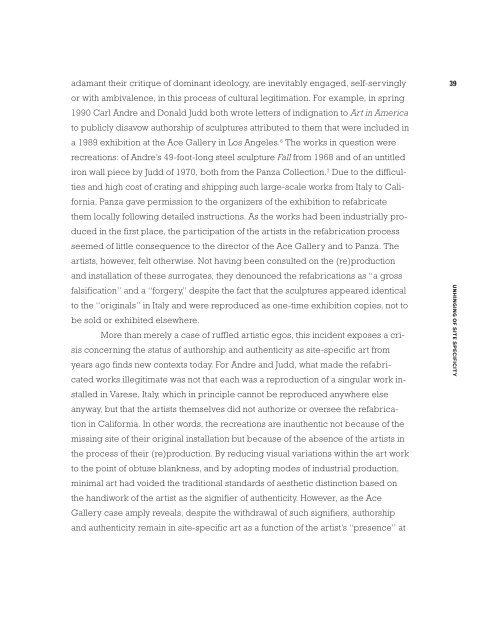ONE PLACE AFTER ANOTHER - Monoskop
ONE PLACE AFTER ANOTHER - Monoskop
ONE PLACE AFTER ANOTHER - Monoskop
You also want an ePaper? Increase the reach of your titles
YUMPU automatically turns print PDFs into web optimized ePapers that Google loves.
adamant their critique of dominant ideology, are inevitably engaged, self-servingly<br />
or with ambivalence, in this process of cultural legitimation. For example, in spring<br />
1990 Carl Andre and Donald Judd both wrote letters of indignation to Art in America<br />
to publicly disavow authorship of sculptures attributed to them that were included in<br />
a 1989 exhibition at the Ace Gallery in Los Angeles. 6 The works in question were<br />
recreations: of Andre’s 49-foot-long steel sculpture Fall from 1968 and of an untitled<br />
iron wall piece by Judd of 1970, both from the Panza Collection. 7 Due to the difficul-<br />
ties and high cost of crating and shipping such large-scale works from Italy to California,<br />
Panza gave permission to the organizers of the exhibition to refabricate<br />
them locally following detailed instructions. As the works had been industrially produced<br />
in the first place, the participation of the artists in the refabrication process<br />
seemed of little consequence to the director of the Ace Gallery and to Panza. The<br />
artists, however, felt otherwise. Not having been consulted on the (re)production<br />
and installation of these surrogates, they denounced the refabrications as “a gross<br />
falsification” and a “forgery,” despite the fact that the sculptures appeared identical<br />
to the “originals” in Italy and were reproduced as one-time exhibition copies, not to<br />
be sold or exhibited elsewhere.<br />
More than merely a case of ruffled artistic egos, this incident exposes a crisis<br />
concerning the status of authorship and authenticity as site-specific art from<br />
years ago finds new contexts today. For Andre and Judd, what made the refabricated<br />
works illegitimate was not that each was a reproduction of a singular work installed<br />
in Varese, Italy, which in principle cannot be reproduced anywhere else<br />
anyway, but that the artists themselves did not authorize or oversee the refabrication<br />
in California. In other words, the recreations are inauthentic not because of the<br />
missing site of their original installation but because of the absence of the artists in<br />
the process of their (re)production. By reducing visual variations within the art work<br />
to the point of obtuse blankness, and by adopting modes of industrial production,<br />
minimal art had voided the traditional standards of aesthetic distinction based on<br />
the handiwork of the artist as the signifier of authenticity. However, as the Ace<br />
Gallery case amply reveals, despite the withdrawal of such signifiers, authorship<br />
and authenticity remain in site-specific art as a function of the artist’s “presence” at<br />
39<br />
UNHINGING OF SITE SPECIFICITY

















